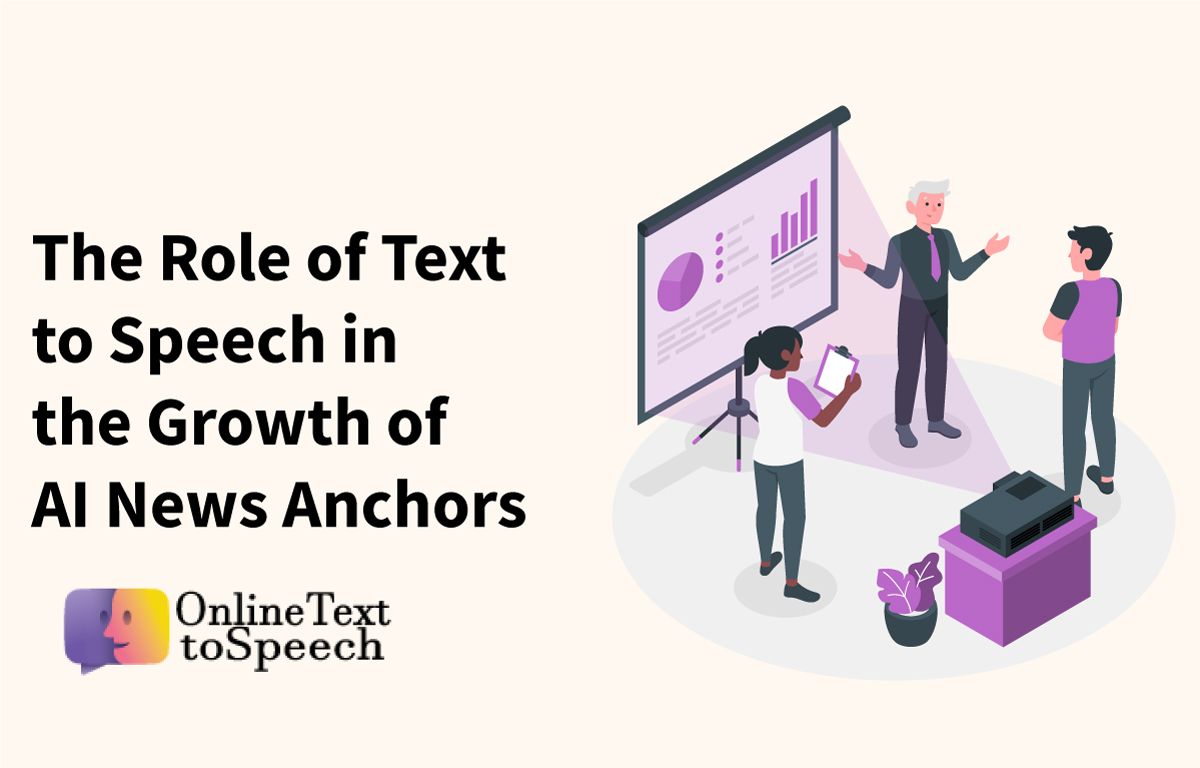
In the ever-evolving digital landscape, automation and artificial intelligence are not just streamlining workflows—they’re reshaping entire industries. One of the most fascinating advancements in this arena is the rise of AI news anchors. These digital personalities, powered by sophisticated machine learning algorithms and text to speech technology, are rapidly becoming a fixture in newsrooms around the world.
From delivering breaking news to hosting entire broadcasts, these AI figures represent a new chapter in media communication. Behind their lifelike articulation lies a complex fusion of data, voice modeling, and natural language processing—tools that have matured significantly in recent years.
As media outlets look for more efficient, scalable, and consistent solutions, text to speech free tools are making this evolution not only possible but also increasingly accessible to content creators and developers at all levels.
AI News Anchors: A Game-Changer in Modern Broadcasting
The media world is no stranger to disruption. Over the past decade, we’ve seen the shift from print to digital, and now, from human to virtual anchors. AI news anchors are created using advanced facial animation software, scripting engines, and—most critically—ai text to speech systems that allow them to speak naturally and convincingly.
These virtual broadcasters are capable of delivering the news in multiple languages, tones, and emotional cadences, all without a live human presenter. That’s the power of synthetic voice technology. As more media companies adopt this innovation, they’re discovering its advantages: cost-efficiency, multilingual reach, and 24/7 availability.
How Voice Tech Powers Virtual Anchors
The voice of an AI news anchor isn’t just a robotic readout—it’s a product of thousands of hours of neural learning. Developers train text to audio free models on massive voice datasets to achieve realistic pronunciation, rhythm, and intonation. The result is a natural-sounding voice that can adjust based on the type of content being delivered.
Whether it’s urgent breaking news or a calm evening bulletin, voice models are now capable of adapting in real-time, making AI anchors not only viable but increasingly preferred. More than just a gimmick, they’re becoming a reliable presence in mainstream media.
Behind the Scenes: Building the Perfect Synthetic Voice
Creating a voice that mimics human speech requires precision and the right tools. Enter text to speech online platforms. These solutions provide the core infrastructure that powers virtual voices across industries—not just media, but also education, healthcare, and customer service.
Training a virtual anchor involves choosing a consistent, high-quality voice model that can be refined over time. These online platforms allow for ongoing customization, letting developers tweak tone, pitch, and emphasis as needed to suit their audience.
The Accessibility Advantage of AI-Powered Speech
AI news anchors don’t just offer novelty—they significantly improve accessibility. For individuals with hearing impairments, these platforms often come with real-time captioning or visual reinforcement. Meanwhile, those with reading difficulties can benefit from free online text to speech services that convert written content into spoken language instantly.
The combination of synthesized voices and visual avatars bridges the gap between digital media and human interaction, making content more inclusive and easier to consume.
Applications Beyond the Newsroom
While news is the primary spotlight for AI anchors right now, the underlying technology has vast potential. The same text to voice generator systems that power newscasters can also be deployed in e-learning, podcasting, and corporate training.
Imagine a branded AI representative that can deliver onboarding instructions, conduct virtual meetings, or narrate marketing materials—without ever needing a studio setup or voice actor. That’s where the scalability and adaptability of this technology truly shine.
Customization and Identity in Digital Broadcasting
One of the biggest challenges—and opportunities—in the growth of AI news anchors lies in voice identity. Content creators want voices that match their brand, resonate with their audience, and reflect cultural nuances. That’s where the power of personalized text to speech voices becomes evident.
With custom voice cloning and character generation, broadcasters can choose specific tones, accents, and pacing to stand out in a crowded content space. Voice is no longer a one-size-fits-all feature; it’s a creative asset.
The Rise of Emotionally Intelligent Voice Generators
Modern audiences expect more than just clear speech—they want connection. Emotionally responsive voice AI can convey urgency, empathy, or enthusiasm based on the script. Thanks to advancements in text to speech generator technology, AI news anchors can now adapt their emotional delivery depending on the story.
This human-like nuance not only improves listener engagement but also builds trust—an essential factor in journalism and public information dissemination.
The Role of Free Tools in Accelerating Adoption
Accessibility to these tools is key. As developers and small content creators experiment with digital broadcasting, they need reliable solutions without heavy licensing fees. Platforms like this free AI text to speech tool are pivotal in making high-quality voice synthesis available to everyone, not just large corporations.
The democratization of this tech is what fuels innovation, allowing new voices—both literal and figurative—to emerge in digital storytelling.
Ethical Considerations and Content Integrity
As realistic AI anchors become more widespread, concerns over misinformation, deepfakes, and editorial bias are growing. Who controls the scripts? How do viewers distinguish real from synthetic?
Media platforms must ensure transparency in labeling AI-generated content and provide accountability for the sources behind what’s being said. With greater power comes the need for stronger safeguards, especially in the realm of public discourse.
The Global Impact of Multilingual AI Anchors
News is a global industry, and not everyone speaks English. That’s why multilingual support is critical. Through AI text to speech and real-time translation, AI anchors can now deliver localized news in dozens of languages, helping publishers reach international audiences without additional resources.
This opens doors for small, regional outlets to compete on a global scale—broadcasting news that reflects their culture and community in a way that’s understandable worldwide.
Automation Without Losing the Human Touch
A common critique of AI in media is the loss of personal connection. But when implemented thoughtfully, AI anchors can complement human journalists, not replace them. Routine stories or time-sensitive updates can be handled by AI, freeing reporters to focus on in-depth analysis and investigative reporting.
Blending text to speech online systems with editorial expertise creates a hybrid model that leverages both speed and substance—a win-win for modern media.
The Future of Broadcasting: Real-Time AI Anchors
One of the most exciting frontiers is real-time broadcasting. Thanks to the speed and efficiency of text to voice generator engines, newsrooms can now deploy AI anchors within seconds of a major event. Scripts can be automatically written, translated, and voiced, allowing for instant coverage without human delays.
This is especially critical in emergency scenarios, where timely, clear communication can save lives.
AI Anchors and Branding: A New Marketing Frontier
Beyond the newsroom, brands are starting to experiment with AI anchors for content marketing. With text to speech voices customized to reflect brand values, companies can produce video updates, thought leadership content, or even host webinars—all powered by AI.
This intersection of technology and branding opens up new forms of engagement that are scalable, cost-effective, and highly targeted.
User-Generated AI Content: The Next Big Wave
It’s not just big media tapping into this trend. Individual creators, influencers, and educators are increasingly turning to free online text to speech tools to create their own AI-generated content. Whether it’s commentary on trending topics or localized news summaries, the barrier to entry is shrinking.
Tools that once required technical expertise are now as easy to use as uploading a script and selecting a voice.
How Small Media Startups Are Winning with Voice Tech
In emerging markets, AI anchors powered by text to speech generator platforms are enabling startups to punch above their weight. With limited resources, these companies can now deliver polished, professional news broadcasts without the costs of studios or full production teams.
The result? A more diverse, decentralized media ecosystem where fresh perspectives and voices can thrive.
Voice Licensing and Intellectual Property in the AI Era
As voice synthesis becomes more refined, creators are also beginning to explore the legal aspects. Who owns the rights to a synthetic voice? Can it be licensed like music or trademarked like a logo?
These are important questions as more platforms and creators leverage text to audio free engines for monetized content. Clear licensing structures will be crucial as this field matures.
The Role of AI Anchors in News Personalization
One of the lesser-known but growing applications of this tech is personalized news. Using user behavior data, AI anchors can adjust tone, content selection, and even delivery timing. Combined with text to speech free systems, this allows publishers to create custom news playlists tailored to individual users.
It’s the Spotify model—except for journalism.
Enhancing Viewer Trust with Transparent AI Use
While innovation excites, trust remains essential. News organizations must be transparent about their use of AI and ensure that audiences understand which content is generated by humans and which by machines. Using watermarks, disclaimers, and editorial oversight helps maintain credibility in this hybrid news environment.
Conclusion
The age of AI news anchors is no longer speculative—it’s happening now. As text to speech technology continues to evolve, it’s reshaping how news is produced, delivered, and consumed. From real-time broadcasting to localized delivery, these digital voices are carving out a lasting space in the world of media.
With responsible development and ethical use, this innovation can enhance journalism, democratize media access, and redefine what it means to stay informed in the digital age.
FAQs
An AI news anchor is a digital character that reads scripted news using synthetic voice and animation, powered by AI technologies.
They can handle routine reporting, but human journalists are still essential for in-depth analysis and investigative work.
Apart from media, it’s widely used in education, healthcare, and customer service.
Yes, many platforms offer basic versions of text to speech free, especially for personal or small-scale use.
You can use a text to voice generator to input your script and select from various voice styles.



